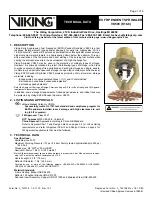
2-20
|
ni.com
Chapter 2
Using the NI PXIe-4300
The trigger circuit generates an internal digital trigger based on the input signal and the
user-defined trigger levels.
For example, you can configure the device to generate an analog comparison event after the
input signal crosses a specific threshold. You also can route the resulting reference trigger event
to the PXI Express trigger bus to synchronize the triggering of other devices in the system.
During repetitive triggering on a waveform, you might observe jitter because of the uncertainty
of where a trigger level falls compared to the actual digitized data. Although this trigger jitter is
never greater than one sample period, it might be significant when the sample rate is only twice
the bandwidth of interest. This jitter usually has no effect on data processing, and you can
decrease this jitter by sampling at a higher rate. Sampling at a rate less than twice the bandwidth
of interest may cause the trigger signal to not reliably be detected.
You can use the following analog triggering modes with the NI PXIe-4300 modules: rising-edge,
rising-edge with hysteresis, falling-edge, falling-edge with hysteresis, entering window, and
leaving window.
Analog Edge Triggering
For analog edge triggering, configure the device to detect a certain signal level and slope, either
rising or falling. Figure 2-12 shows an example of rising edge analog triggering. The trigger
asserts when the signal starts below level and then crosses above level.
Figure 2-12.
Analog Trigger Level
Level
a
nd
S
lope of
S
ign
a
l Initi
a
te
s
D
a
t
a
C
a
pt
u
re
0
3
.2 V
Level
Reference Trigger
An
a
log Comp
a
ri
s
on









































